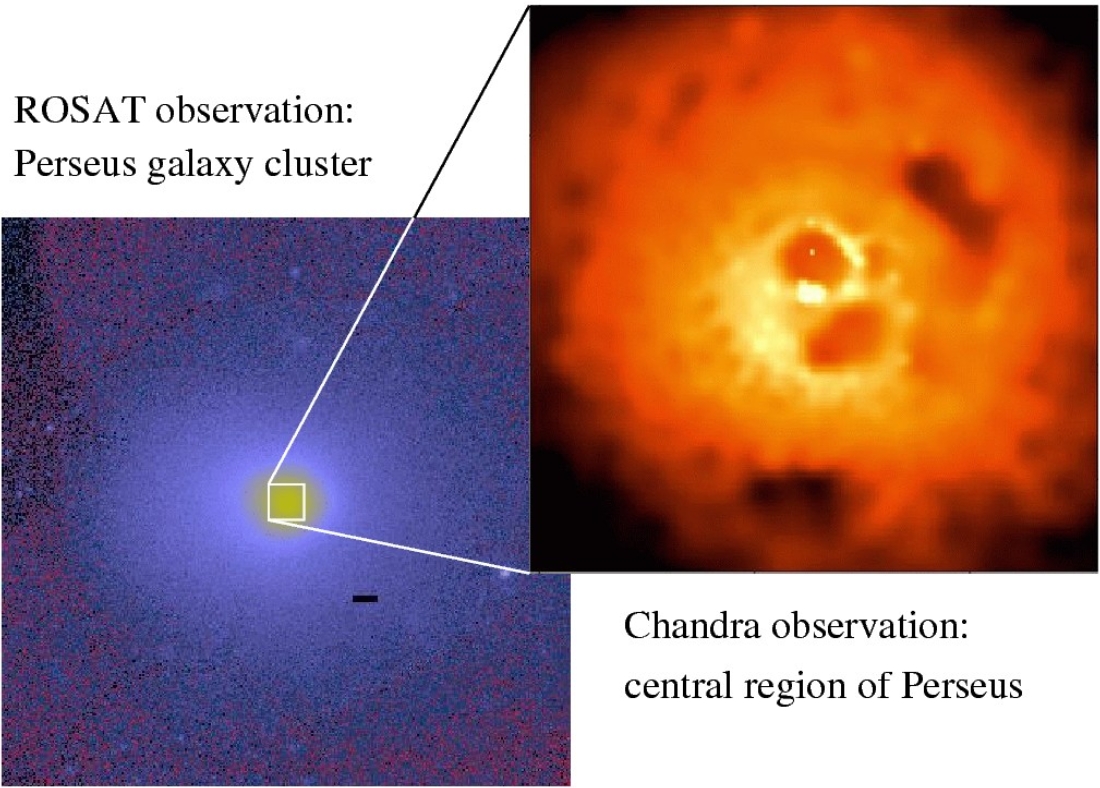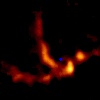|
|
 |
 |
 |
 |
 |
|
3C84 in Perseus A: High-Energy Processes in The Center of The Cooling Flow Cluster of Galaxies
|
|
| |
 |
- Investigators
Jun-Hui Zhao (CfA), Melvyn C. H. Wright (U.C. Berkeley), John Wardle (Brandeis), Ligong Mi and Xiang Liu
(Xinjiang Obs.), Thomas Krichbaum (MPIfR) et al.
- Introduction
Located at the center of the Perseus cluster, 3C84 is a strong radio source.
With the SMA and CARMA, we are monitoring the radio variations of 3C84
at submm/mm wavelengths. The radio source currently shows an increase
in flux density, suggesting that 3C 84 is in a pre-flare state. The
fluctuation of the flux-density curve indicates that the radio source
is bubbling. As soon as the source reaching a flare state with a
flux density level comparable to the 1979/1980 event, we will
ask VLBA target of opportunity (ToO) observations of the sources to
study the process of jet ejection from the SMBH. Located in the center
of the cooling flow cluster, 3C84 is an excellent astrophysical laboratory
for testing jet formation theory. The X-ray cooling inflow appears to
provide not only strong ram pressure to confine the radio plasma outflow
but also a fueling mechanism for powering the central engine. The mm/submm
radiation flux monitoring and VLBA imaging along with X-ray, optical and
IR observations are
the critical means to understand the ecological cycle of a SMBH at the
center of a cooling flow cluster. In particular, along
with the ongoing activities of high-energy observations
from various gamma-ray telescopes, the ToO VLBA observations will provide
us critical information on the high-energy processes occuring in the core
of 3C84. Below are the CARMA+SMA monitoring
lightcurve and an incompleted review of previous researches in radio,
optical, X-ray and gamma-ray observations, which is in the preparation
for the VLBA ToO observation proposal.
- X-ray observations - Cooling flow
3C84 is a radio source in Perseus A Galaxy (NGC 1275), located at the center of
the rich cluster of galaxies Abell 426, which has a heliocentric recession speed of 5,366 km/s
(z=0.0179 or 73.6 Mpc) and a diameter of 863 arcmin, with a richness class of
2. It contains 190 member galaxies. It hosts the nearest large cooling
flow, with X-ray luminosity of 4 x 1045 erg/s. Subarcsec-resolution
X-ray imaging core of the Perseus cluster around the galaxy NGC 1275
with the Chandra X-ray Observatory has revealed the detailed structure
of the X-ray emission gas. Recently, Fabian etal (2011) published a
Chandra 1.4 Ms image.

- Optical emission lines observations - Emission line filaments and threads
The long exposure optical image below shows
the giant elliptical galaxy NGC 1275, the dominant member at the
center of the Perseus cluster
and NGC 1272 (5 arcmin WSW of NGC 1275), the second brightest
member. The NASA Hubble Space Telescope (HST) Halpha line image
shows a well-known giant nebulosity of emission-line,
which are dragged out from the center of the galaxy by
the radio bubbles, blowed out from the SMBH,
rising buoyantly in the hot intracluster gas
before later falling back (Rayleigh-Taylor instability).
The newly found thread/filament structure of the emission line
suggests that the threads are supported by magnetic fields and in
pressure balance with the ambient gas. The stablized filaments
allow a large mass of cold gas to accumulate and delay star formation
(Fabian et al 2008).

Left:Chandra composite image of the 1.4 Ms exposure in
the 0.5-7 keV band. Right: Optical image from Blackbird Observatory
in Sacramento Mountains of New Mexico USA.
The images are 11.8 arcmin from N to S (Fabian etal 2011).

HST image of NGC 1275 with the red filter (F625W) contains
the H alpha line (Fabian etal 2008). The image measures
140x150 arcsec in size.

The VLA images of Perseus cluster at 333 MHz with the C and D
array configurations at 50x50 arcsec (upper) and the D array
alone (170x164 arcsec) showing the radio halo strucrure
in 3C84 at the cooling flow center (Burns etal 1992).
- Radio observations (high-frequency & high-resolution) -
Radio flare, jet outflow and SMBH
A large flare was caught by
Dent etal (1983)
with the NRAO 36-foot antenna at 31.4 GHz and FCRAO 14-m at 89.6. At 89.6 GHz,
the flux density rose from 42 Jy to 75 Jy between 26 October 1979 and 13 March 1980
at a rate of 140 Jy y-1. Following the millimeter outburst, the VLBI observations
were made at 89 GHz by Backer etal
(1987) and at 100 GHz by Wright etal (1988)
during the flare. From 6 epoch observations at 22.3 GHz from 1981 to 1986,
Marr etal (1989) determined that the projected velocity of jet motion
is 0.49+/-0.10 c. Model fitting to the fringes
suggested a halo structure.
Multiple epoch observations with VLBI showed the further evidence for the proper motions
in the main jet (south to the core)
by Walker et al (1994) and
Vermeulen etal (1994).
The kinematics of the inner jets were revealed in the VLBA high resolution images at 15 and 43 GHz
observed
by Dhawan et al (1998).
The detailed structure was imaged with the VLBA at multiple frequencies
of 2.3, 5.0, 8.4, 15.4, 22 and 43 GHz
by Walker et al (2000).

Image courtesy of NRAO/AUI. The VLBA/VLA (one antenna) image of
3C84 observed at 22 GHz on October 1995 with angular resolution
of 73x43 micro arcsec. Also see Walker et al (2000) for the full story.
- Radio observations (polarization) - Faraday RM screen & magnetic fields
Polarization study was carried out by the Brandeis group.
Significant circular polarization was detected
by Homan & Wardle (2004) with the VLBA at 15 and 22 GHz. Linear polarization
has been detected with the VLBA at 4.8, 8.4, 15.1 and 22 GHz revealing Faraday RM 6500 to 7500 rad m2
by Taylor etal (2006),
suggesting 4 microG, a lower limit B-field in the RM structure of 10pc with 10 electron cm-3.
The thread structure observed in X-ray emission suggested that the B-field is tens microG to
100 microG (Fabian etal, 2008).
However, recent IRAM-PdBI observations
showed 3-sigma upper limits on linear polarization of
0.5% and 1.9% at 239 and 348 GHz, respevtively,
suggesting that 3C84 is strongly de-polarized by
the small-scale (~1 pc) Faraday RM structures
with Delta RM > 106 rad m-2
Trippe et al. (2012) .
- High-Energy Gamma-ray
FERMI-LAT detection of Gamma-ray (>100 Gev)
from NGC 1275 (Abdo et al. 2009, ApJ 699, 31).
The average flux and power-law photon index measured with the LAT from
2008 August 4 to 2008 December 5 are F = (2.10 +/- 0.23) x 10-7 ph
(>100 MeV) cm-2 s-1 and Gamma = 2.17 +/- 0.05,
respectvely.
Contemporaneous and historical radio observations are also reported. The broadband spectrum of NGC 1275 is modeled with a simple one-zone synchrotron/synchrotron self-Compton model and a model with a decelerating jet flow.

FERMI-LAT: 100 MeV to 200 GeV gamma-ray image centred on NGC 1275 (RA =
49o.951, Dec. = 41.o512) with a ROI of
8o smoothed with a 3o Gaussian.

FERMI-LAT: The 2yr light curve of 800 MeV to 200 GeV gamma-ray flux
from NGC 1275 binned in week interval, as detected by Fermi-LAT
with a ROI of 1o.
Both image and light curve from Brown and Adams 2011 MNRAS, 413, 2785
- Very-High-Energy Gamma-ray
MAGIC detected NGC 1275, average flux above 100 GeV is F = 1.3+/- 0.2stat
+/- 0.3syst) x 10-11 cm-2 s-1 and
the
differential energy spectrum between 70 GeV and 500 GeV can be
described by a power law with a steep spectral index of GammA = (4.1 +/-
0.7stat +/- 0.3syst) (see Aleksic et al. 2012, A.A. 539, L2).
| |
| |
| |
|












